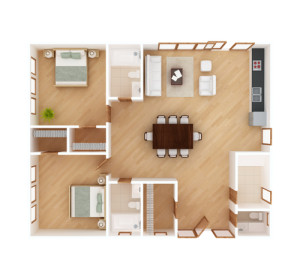 Okay, so it's not the Titanic. It's your new house and you can't seem to make your older furniture fit. Buying new furniture is out of the questions, so how do you make your round pegs fit into those square holes?
Okay, so it's not the Titanic. It's your new house and you can't seem to make your older furniture fit. Buying new furniture is out of the questions, so how do you make your round pegs fit into those square holes?
Make a plan
Literally … make a floor plan. This can be a rough sketch, or a sophisticated layout, but having a floor plan helps you visualize your options. You can find some useful tools on the Internet to create a basic layout and add virtual furniture. Here is a list of programs to choose from with different options.
Create a couple of options. Since a floor plan doesn't give you a sense of height, you may need to try taller or shorter pieces in various locations to see what works for you.
Have an open mind
When your new space is a different shape from your old space, you need to change how you think about space. Often, we place our seating furniture against one wall and our entertainment center opposite and fit everything else in-between. Consider different groupings for different purposes. Do you watch TV with a large group of friends, or just the two of you at the end of the day? If it's just the two of you, group your favorite seating with your entertainment area and move other seating to the opposite end of the room as a conversation area.
Empty the room
When the movers place everything in the room, the extra boxes, bunched up furniture and general clutter hampers your ability to visualize arrangement options. Move as many boxes and furniture out of the room as possible and bring them in one at a time as you form your arrangement.
Place large pieces first
Set your sofas, cabinets, large storage pieces and tables first. Try the different options from your plans to see which one feels right. Don't be afraid to use a large shelf as a room divider. If your new living room is much longer than your old one, you may find it cozier to split it up. Group a couple of chairs near a window for reading or set two sofas back to back … one for watching television and one for conversation.
On a side note: wait to hang pictures and wall ornaments until you're satisfied with the basic furniture arrangement—it saves repairing holes in the walls.
Don't hug the walls
Free up your options by moving furniture away from the walls. There is no rule stating that the sofa must be against a wall. Bring your seating toward the center of the room anchored by a rug, coffee table or trunk. Check out these images for ideas.
Try again…
Once you've set up an arrangement, try it for a week or so. Adjust your smaller pieces—lamps, side tables, smaller bookshelves and artwork—to compliment the larger pieces. If it feels crowded after a week, consider removing a piece. If it seems off-balanced, try placing larger pieces opposite of each other. If it feels empty, consider a piece of furniture or décor to fill the void … then start shopping. But don't buy until you're sure it's what you want. After a few months, you may change your mind or feelings about the arrangement.
Therapy
For those of you that love to rearrange furniture—you know who you are—your spouse or significant other (or friend you always call to help you move things) will thank you for using the planning tools and ideas ahead of time.
Compliments of Virtual Results